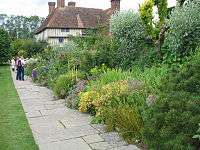Great Dixter

Great Dixter is a house in Northiam, East Sussex, England. It was built in 1910–12 by architect Edwin Lutyens, who combined an existing mid-15th century house on the site with a similar structure brought from Benenden, Kent, together with his own additions. It is a Grade I listed building.[1] The garden, widely known for its continuous tradition of sophisticated plantsmanship, is Grade I listed in the National Register of Historic Parks and Gardens.[2]
House

The original Northiam house, known as Dixter, dating from the mid-15th century, was acquired by a businessman named Nathaniel Lloyd in 1909. He had a 16th-century house in a similar style moved from Kent and the two were combined with new work by Lutyens to create a much larger house, which was rechristened Great Dixter. It is a romantic recreation of a medieval manor house, complete with great hall, parlour, solar and yeoman's hall.[3]
Garden
Lloyd and Lutyens began the garden at Great Dixter, but it was Lloyd's son Christopher Lloyd, a well known garden writer and television personality, who made it famous. The garden is in the arts and crafts style, and features topiary, a long border, an orchard and a wild flower meadow. The planting is profuse, yet structured, and has featured many bold experiments of form, colour and combination. The garden is currently managed by Fergus Garrett, who worked closely with Lloyd up until his death in 2006 as Head Gardener and introduced a number of innovations into the planting scheme.[4]
In the grounds of Great Dixter are three 18th-century oast houses, under a common roof, and a 15th-century barn. These are Grade II* listed.[5]
 Porch
Porch Detail of porch
Detail of porch Front door inside porch
Front door inside porch Oast houses
Oast houses Roof beams inside thatched barn
Roof beams inside thatched barn
Management
The house and garden are open to the public for part of the year. Study days, workshops and lectures are held frequently. A charity called the Great Dixter Charitable Trust has been established to ensure that the property is preserved.
References
- ↑ Historic England. "Great Dixter (1216957)". National Heritage List for England. Retrieved 3 March 2014.
- ↑ Historic England. "Great Dixter (park and garden) (1000736)". National Heritage List for England. Retrieved 3 March 2014.
- ↑ Information from free Great Dixter leaflet
- ↑ Dickey, Page (June 2006). "The Lessons of Great Dixter: Christopher Lloyd designed garden". House & Garden. 175 (6): 144–151. Check date values in:
|access-date=(help); - ↑ Historic England. "Oasthouses and barn at Great Dixter to the north west of the house (1216899)". National Heritage List for England. Retrieved 3 March 2014.
External links
| Wikimedia Commons has media related to Great Dixter. |
Coordinates: 50°59′48″N 0°35′30″E / 50.99667°N 0.59167°E